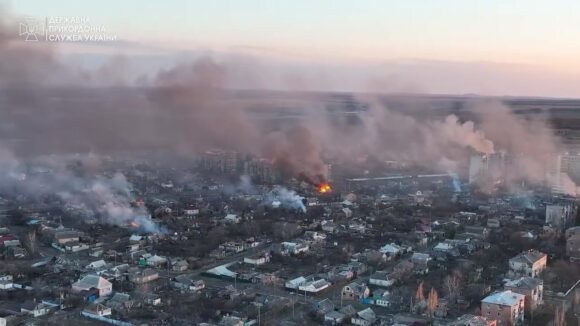At least five people have died in the latest round of overnight strikes across Russia and Ukraine, as both sides continue to engage in relentless drone warfare. The exchange of attacks underscores the escalating conflict, even as diplomatic efforts to broker a ceasefire remain stalled.
Ukrainian officials reported on Saturday that Russia had launched more than 200 drones and nearly 30 missiles, with the majority targeting the Dnipropetrovsk region. Three people were killed in the strikes there. In addition to the fatalities, six others were injured, according to regional authorities. The city of Dnipro saw damage to residential buildings and industrial areas, while a shopping centre in the wider district was also hit.
On the other side of the border, Russia’s Rostov region reported two deaths after a Ukrainian drone strike set a car ablaze. The region’s acting governor confirmed the fatalities, adding to the growing civilian toll as the war enters a new phase of technological escalation.
The attacks came as both Russia and Ukraine offered updates on their respective military campaigns. Russia’s Ministry of Defence claimed that its forces had captured two villages: Zelenyi Hai in the Donetsk region and Maliivka in the Dnipropetrovsk region.
Meanwhile, Ukrainian President Volodymyr Zelensky said that Ukrainian troops were “gradually pushing Russian forces out” of the Sumy region. He noted that although Sumy remains a key focus for Russian forces, Ukrainian defenders were effectively blocking any attempts to advance deeper from the border areas. There were reports that the village of Kindrativka had been liberated from Russian control.
In an update posted on X (formerly Twitter), Zelensky stated that Russian strikes had also targeted the regions of Kharkiv and Sumy. He emphasized that these attacks “cannot be left without response,” and defended Ukraine’s continued use of long-range drones as retaliation. Zelensky added that strikes on Russian military sites and airfields were delivering “real consequences,” arguing that these drone attacks were among the “arguments that will surely bring peace closer.”
The Ukrainian president also provided updates on battlefield activity in Donetsk, stating that there had been “51 intense combat engagements” in the Pokrovsk area in the last 24 hours. He described the fighting as part of an effort to defend key positions from further Russian advances.
Despite the ongoing violence, diplomatic initiatives persist, albeit with little progress. Earlier this week, Ukrainian and Russian delegations held a third round of ceasefire talks in Istanbul. The discussions, which took place on Wednesday evening, failed to produce any tangible breakthrough. Both sides accused each other of rejecting proposals and refusing to compromise.
This round followed two previous talks in May and June, which were held at the urging of U.S. President Donald Trump. Trump has repeatedly expressed his desire to see an end to what he calls the “horrible, bloody war” that erupted following Russia’s full-scale invasion of Ukraine in 2022.
As the conflict drags on with no end in sight, drone warfare continues to play a prominent role in both sides’ strategies. The repeated attacks and counterattacks by unmanned aerial vehicles are not only causing increasing destruction and loss of life, but also highlighting the ongoing failure of diplomatic efforts to halt the war.






